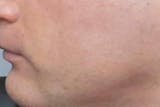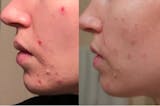
Our skin lets us touch and connect with loved ones and protects us from germs that can make us sick. It’s a home that attaches us safely to the world.
But it’s not a home that’s ours alone. We share our skin with billions of invisible roommates, called microbes. They come in all shapes and sizes and live in close harmony with each other and our skin in an intimate alliance.
Collectively this diverse group of tiny helpers is called the skin microbiome and is necessary for maintaining our skin health and overall well-being.
In this article, we dig beneath the surface to talk more about what the skin microbiome does, the importance of keeping it healthy, its role in certain skin diseases, and how skincare can work with or against it.
Where Does the Microbiome Live on Your Skin?
What Factors Affect Your Skin Microbiome?
Functions and Benefits of a Healthy Skin Microbiome
The Microbiome and Skin Disease
Skincare Products and Your Microbiome
Changing Your Skin Microbiome for the Better
What is the Skin Microbiome?
The skin microbiome is a community of bacteria, fungi, viruses, and other organisms that live on and beneath the surface of our skin (i.e., sweat glands, oil glands, or hair follicles).
Many of the microbes on your skin are friendly partners: Our skin provides pleasant living conditions and in return, the microbial community promotes skin health, playing a key role in how it looks, feels, and functions. For the most part, it’s a win-win symbiosis.
Much like our fingerprint, your skin microbiome is unique to your biology. There is a large degree of variation between people’s microbiomes, depending on their sex, age, lifestyle, geography, and other environmental factors.
Where Does the Microbiome Live on Your Skin?
Different areas of our skin favor or discourage the growth of certain types of microbes. For instance, oily parts of the skin, like your forehead, have different microbes than dry parts of the skin, like your forearm. Which microbe grows where depends on various factors, including moisture, temperature, other microbial community members, etc.
Different types of microbes can inhabit various layers of the skin. The outermost layer of skin, called the epidermis, contains a diverse collection of microbes, distinct from those found in the inner layers of the dermis, where sweat glands, hair follicles, and oil glands can shape what types of bacteria, viruses, and fungi can survive and thrive there.
What Factors Affect Your Skin Microbiome?
Certain microbes on our skin are constantly shifting depending on the diverse environments we find ourselves in. This natural shift occurs throughout your life, permitting adaptation to new conditions. If you start a new medication, try new cosmetics, get a pet, or move with your family to a new location, these changes can revamp your skin’s microbial community.
As babies, your skin microbiome is shaped by early-life events. Infants born vaginally acquire their first skin microbes from their mother’s vagina, while those born through Caesarian section acquire skin microbes through interactions with their family's skin. Other age-related events, such as puberty, lead to significant shifts in the composition of pre-puberty skin microbiomes.
Many other factors can affect the core composition of your skin microbiome and how it compares to other people. These factors include:
- Age
- Lifestyle (urban/rural living, pets, etc.)
- Season, climate, and geographical location
- Sex
- Genetics
- Height and weight
- Antibiotic use
- Hygiene routine
- Cosmetics use
The Functions and Benefits of a Healthy Skin Microbiome
Many microbes that coexist with your skin directly or indirectly affect your skin's functions. But the community and the intimate connection between community members and our skin are the most important for skin health.
The role of the skin microbiome in maintaining skin health includes:
- Control inflammation: Certain skin microbes can also prevent excessive inflammation and exert an anti-inflammatory effect, promoting healthy skin. They also can help limit extreme inflammation during injury, preventing additional damage to your skin and other areas.
- Fighting off “bad” microbes: The skin microbiome protects against invasion by harmful bacteria. They can produce inhibitors that directly kill microbial invaders and help maintain a strong barrier against the environment.
- Tuning your immune system: The skin microbiome adjusts your immune system’s activity to invading bacteria or viruses.
- Skin renewal: The cells that make up your outer layer of skin die off in a normal process and are replaced by new cells. Your skin microbiome helps keep this process moving.
- Wound healing: The balance and composition of your skin microbiome can affect how quickly wounds heal, particularly with the frequent wounds that can occur in those with diabetes.
These functions and benefits result from substances produced by the microbial community living on your skin. For instance, some microbes use oily secretions on our skin to make a special chemical that maintains the normal pH of our skin and prevents invasion by harmful bacteria. There are many other examples of this give-and-take relationship between your skin and the microbiome.
The Microbiome and Skin Disease
Sometimes the composition of your microbiome can become unbalanced. As a result, your skin can become inflamed, promote invasion by harmful bacteria, or prevent complete healing after broken skin occurs. This imbalance in the microbiome is called dysbiosis and has been linked to several short-lived and chronic skin conditions, such as eczema and psoriasis.
Eczema
Eczema, also called atopic dermatitis, is a chronic inflammatory skin condition. There are multiple risk factors:
- Skin barrier impairment
- Immune system over-activation
- Microbiome imbalance
An unbalanced microbiome is common in eczema flare-ups and can lead to relapse in children and adults. An imbalance of common bacteria is natural in people with eczema or those experiencing flare-ups as their skin lacks long-chain ceramides and provides an environment for the imbalance.
These microbes drive an increase of inflammation in the already troubled skin. In cases where there is significant itchiness, scratching can allow an infection to take hold. Doctors therefore may recommend treatments with antibiotics or bleach baths to control the chance of worsening infection or to reduce the inflammation.
While there is some dispute over how effective these treatments are, they tend to reduce the harmful bacteria associated with eczema.
To learn more about how eczema works and find the right treatment for you, please check out our article on The Science of Eczema.
Psoriasis
Psoriasis is another inflammatory skin disease that can cause itchy, scaly patches in the area around the knees, elbows, and scalp. While there is much unknown about the disease, multiple factors can trigger onset and progression:
- Injury to the skin
- Bacterial infections
- Microbiome imbalance
As with eczema, an imbalance in the microbiome is associated with psoriasis, though its direct role in the process is still unclear. A common fungal microbe found on human skin, Malassezia, is often found in lower abundance in people with psoriasis compared to healthy individuals. Another fungi, Candida, is elevated in those living with psoriasis.
Acne, Rosacea, Vitiligo, and Others
Microbiome imbalance in the normal human skin microbiome is suspected of playing a role in several other complex skin disorders, including acne, rosacea, vitiligo, and others.
Skincare Products and Your Microbiome
There’s been a significant focus on finding ways to shift unbalanced skin microbiomes back into balance using specialized skincare products.
Commonly-used cosmetics are already known to shape your microbiome, some in a positive direction, some in a negative direction. For example, certain preservatives used in cosmetics will prevent the growth of microbes, while some emulsifiers commonly used in cosmetics can promote the growth of harmful microbes.
Skin care brands have been promoting products targeted to either shifting your microbiome or maintaining a healthy microbiome.
The terms you need to look out for are "prebiotic", "probiotic" and "postbiotic".
Prebiotics
Prebiotics act as nutrient-rich food for very specific microbiome members already on your skin. Healthy food nurtures a healthy microbiome, stimulating beneficial microbes' growth and inhibiting harmful microbes' growth.
Prebiotics also have several advantages over other approaches. Prebiotics are can be simple ingredients added to skincare products and are generally stable at room temperature. Prebiotics are also small enough that they can enter the deeper layers of the skin, where they can reach the microbes that reside there. They help create an environment where a healthy microbiome can thrive. As a result, they can help strengthen your microbiome and even shift it to health.
In a similar approach, researchers have examined using prebiotics in the gut to produce substances that can regulate inflammation and improve your skin health. There is some evidence that infants with atopic dermatitis can benefit, though more work is required to determine the conclusive benefits.
Given the advantages discussed above, applying prebiotic skincare products directly to the skin is a more direct and favorable alternative to using gut prebiotics or the topical probiotics discussed below.
Probiotics
Probiotics are live microbes that can be added to skincare products in an attempt to promote skin health and counteract a microbiome imbalance.
Much research has investigated if probiotics are effective for certain diseases but there is still a lot of uncertainty as to effectiveness.
Common probiotic bacteria such as Lactobacillus, Bifidobacterium, and others are under investigation, and some promising studies on their ability to promote healthy skin and anti-aging effects. However, some probiotic microbes being investigated aren’t members of your regular skin microbiome, and the chance that they take up residence on your skin or provide a long-term benefit appears unlikely.
For specific skin conditions, like eczema, in-depth reviews of the evidence for probiotics have come up short: In children and adults, proof of the benefit of using probiotics is inconsistent. There is even more uncertainty about the overall safety of probiotics, and few studies look at harm due to probiotics.
A probiotic approach has proven challenging to implement. Often the resident microbes are there because the environment is favorable for them and so they are not displaced by the new microbe. Microbes tend not to survive long in cosmetic packaging and need to be refrigerated to survive raising the cost of products.
Unfortunately, the term "probiotic" has come to be referred to by the industry to represent both living microbes and dead microbes, in whole or in part. As a result there are a number of misleading claims about what the consumer is getting in their skin care.
Postbiotics
Postbiotics are the outputs of live microbes. Some common examples are alcohol and vinegar. There are many substances that we produce using fermentation to create postbiotics.
Postbiotics can affect the living environment for the microbiome, but are generally an industry buzz-word to relabel an existing ingredient.
Changing Your Skin Microbiome for the Better
If you’re experiencing chronic or short-term skin problems and an accompanying imbalance in your microbiome, you may need help to tip the scales back in your favor.With your newfound knowledge and appreciation of the power of your skin microbiome, consult with a dermatologist to address any issues and choose treatments that are right for you. You may also take a look at our Skin Health Intelligence Kit which can aid your journey with your doctor by giving you a peak into the microbiome on your skin.
Interest in pro- and prebiotic solutions is growing, and more research will relieve those living with skin conditions that currently have insufficient options.
The Rulo Solution: BioBloom™
At Rulo, we want to empower you and your skin. We’ve created a patent-pending prebiotic, BioBloom™. It works to create a healthy environment for your microbiome to flourish, and in the process it produces long-chain ceramides which are associated with a strong skin barrier.
References
We are a team of scientists and physicians who deeply research to bring you the latest accurate information. Wherever possible we cite 3rd party research that is not backed by industry labs. Below are the papers we used to bring you this article.
Revised Estimates for the Number of Human and Bacteria Cells in the Body
The microbiome extends to subepidermal compartments of normal skin
Bacterial Community Variation in Human Body Habitats Across Space and Time
Topographical and Temporal Diversity of the Human Skin Microbiome
New Insights into the Intrinsic and Extrinsic Factors That Shape the Human Skin Microbiome
Functions of the skin microbiota in health and disease
Activation of TLR2 Enhances Tight Junction Barrier in Epidermal Keratinocytes
Compartmentalized Control of Skin Immunity by Resident Commensals
Temporal stability in chronic wound microbiota is associated with poor healing
The Neuropathic Diabetic Foot Ulcer Microbiome Is Associated With Clinical Factors
Commensal bacteria regulate TLR3-dependent inflammation following skin injury
Staphylococcus aureus and S. epidermidis strain diversity underlying human atopic dermatitis
Staphylococcus aureus in the lesions of atopic dermatitis
Dysbiosis and Staphylococcus aureus colonization drives inflammation in atopic dermatitis
Molecular characterization of the skin fungal microbiome in patients with psoriasis
Effects of Tween 80 on Growth and Biofilm Formation in Laboratory Media
Probiotics for treating eczema
About The Author
Dr. Nicole Scott, PhD, MPH has published 29 peer-reviewed papers regarding human biology and the microbiome. Her work has been cited over 4000 times.
She is the Founder of Cybele Microbiome and Rulo Skin.


